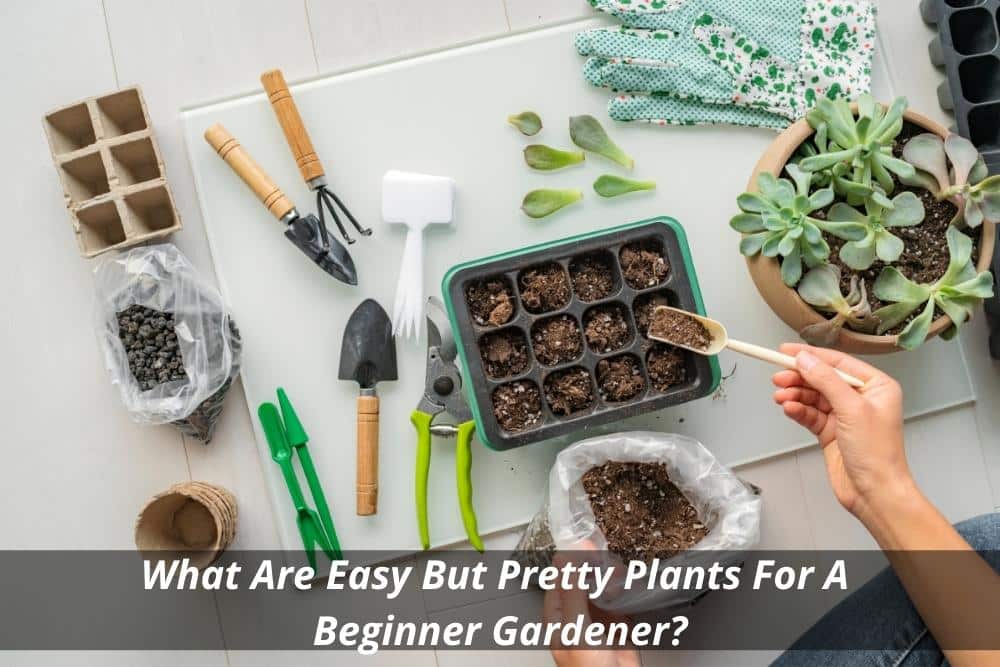Gardening has become quite popular these days. People love spending time outdoors, especially during summertime. If you want to get into gardening, search for a “landscaper near you” or hire a landscaper for some tips then you should start off with something simple. There are plenty of easy but pretty plants for beginners.
Gardening requires patience, persistence, and lots of practice. The good thing about gardening is that it can be done anywhere at any time. All you need is a little space and some basic tools.
There are several types of flowers that are suitable for beginners. These include annuals, perennials, bulbs, shrubs, trees, vines, herbs, and vegetables. Some of them are very easy to care for, while others require a bit more effort.
Annual plants grow quickly and bloom in one season only. You will find many species of annuals such as marigolds, sunflowers, zinnias, cosmos, impatiens, and petunias. Annuals are great because they do not take up much space, so they are perfect for small gardens or balconies. However, if you have limited space, then you might consider choosing other options like perennials.
Perennial plants continue blooming throughout the entire growing season. They also spread easily through roots and seeds. Most of them are evergreen which means they never stop producing leaves all year round. Perennials are best for larger yards or areas with ample space.
There are three main varieties of bulbs: spring-flowering tulips and daffodils; fall-blooming crocuses and hyacinths; and winter-flowering snowdrops, amaryllis, ranunculus, and irises. Bulbs provide instant early colour. In fact, many people think of tulip bulbs as the quintessential spring flower. But there’s no reason why you shouldn’t enjoy stunning displays from your garden bed any time of year.
If you’re looking for something colourful and beautiful, then flowering bulbs and shrubs are surely going to meet your expectations. You could either choose hardy ones that will survive harsh winters or tender ones that won’t last too long.
With a wide range of colours and shapes, flowering shrubs are a must-have item in every backyard. This includes both deciduous (leaves drop each autumn) and coniferous (needles remain on the tree right until next spring).
The beauty of herbaceous plants cannot be matched by any other type of plant. Their large and varied foliage gives them an elegant appearance. Herbaceous plants come in various shades of green, yellow, red, blue, purple, white, orange, pink, and even black. They are mostly used to decorate landscapes, patios, and decks.
Vines are another favourite among homeowners who prefer to add to their outdoor décor. Vines can climb trellises, fences, walls, and windows. Many different kinds of climbing vines are available, including daylilies, hops, clematis, morning glory, honeysuckle, wisteria, and jasmine.
Climbing roses are usually planted around the house or on a fence, providing a lovely backdrop against the background of your home. Roses bring out a feeling of romance and warmth whenever they are in full bloom. They can be kept in pots or planted directly in the ground.
You may be wondering what else to add to your garden or front yard. Here are some ideas:
- A pond — nothing says “I live in paradise” than a fishpond!
- Garden furniture — whether you opt for patio sets or classic garden chairs, these items make your garden look more inviting.
- Landscape lighting — when light floods into the landscape at night it creates a serene atmosphere. It is particularly useful during summer long nights.
- Fountains — water features really improve the look of an otherwise uninteresting area.
A good rule of thumb is to use flowers, vegetables, herbs, or fruits that you normally eat since this will ensure that you can enjoy eating your own produce while admiring its beauty.
We hope our list has given you enough inspiration for your next gardening adventure.
Do I have to water these plants every day?
Some plants need extra attention to grow well, like most trees and shrubs. Others need minimal care, such as annuals, which simply need watering once per week or fortnightly in dry weather. When you consider how much money you spend buying fertiliser, pesticides, soil amendments etc, it makes sense to give them as little attention as possible so you don’t lose money on plants.
When the weather starts warming up again, take a minute to check your indoor planters and pick out the best-looking plants and arrange them in the sunniest spot. If you’re not sure what will do well indoors, get a book about growing tropicals. Tropical plants do really well in warmer climates and require less maintenance than temperate zone plants.
Watering Tips For Plants
As mentioned before, most plants can be left without too much worry; however, there are several things that you should keep in mind when caring for your indoor plants. In general, if you water them regularly, they will thrive better.
While it’s true that many plants love lots of water, not all types have the same needs. Some plants prefer to sit in a moist environment while others appreciate drier conditions. The following information will help you decide which plants you want to grow inside and the amount of water each requires.
First, let’s talk about those plants that prefer warm environments. These include succulents, cacti, ferns, and some aloe vera varieties. Not only does hot, humid air provide moisture for plants, but it also helps them absorb nutrients faster by making their leaves softer and more pliable. This means that a plant placed in a cool location that receives plenty of sunlight can still develop strong roots and leafy green growth no matter how cold it gets.
Second, we’ll focus on those plants that prefer cooler temperatures. Most people think that because they live in a cooler climate, they must be able to tolerate colder conditions. However, even though you might not feel comfortable with temperatures below freezing, it doesn’t mean you can’t grow plants outside during the winter months.
Just remember to protect your outdoor plants from snow build-up and harsh winds that could damage their tender new leaves. You can also try using an insulated planter to make sure that it stays nice and warm inside.
Finally, there are those plants that do equally well at both high heat and low. These include palms, philodendrons, spider plants, and bromeliads (which include pineapple). They all prefer bright light, but not full sun. As a result, many indoor plants won’t fare well in direct sunlight.
Try to position them where they receive natural light, like under large windows or on south-facing shelves. If you need to place them somewhere else, look for shades or indirect lighting.
Plants come in various sizes and shapes. Here’s a simple way to determine if you’ve got the right variety for your space: measure the height of the container first, then multiply that number by two. That number is the maximum width of the pot. Now subtract one inch from that measurement to find the minimum depth.
Remember this as you select plants. The smaller pots are a great choice for small containers, such as window sills and tabletop gardens. Larger pots will allow you to fill them with soil and put larger plants or trees in them.
If you already know that you’d like to start a garden, but aren’t quite ready to dive into a major project, consider starting with a few inexpensive plants instead. It’s easy to add additional plants later on, as you learn more about gardening and plants.
Your first step should be choosing a type of plant you enjoy, whether it’s flowering bulbs or ornamental grasses. Once you narrow down these possibilities, take a trip to a local nursery shop. There, you can get advice on what plants will work best in your area, and you can pick out a few specimens to see how they grow indoors.
To save money, choose plants that are sold in small quantities or containers. Also, check out online retailers for the best deals on seedlings, so you don’t have to buy a whole bunch of seeds just to start your own little patch.
Growing herbs is easier than growing vegetables or fruits. So, why would anyone bother trying to grow any other kind of plant, especially a fruit tree or vegetable? Well, they’re very good-looking, they require less care, and they’re usually much easier to grow.
What makes them so popular? First, they’re beautiful, colourful, fragrant, edible, and useful. Second, they’re fairly easy to grow. Third, they don’t require lots of room.
Fourth, they offer the best return on investment when compared to buying store-bought versions. And finally, they’re environmentally friendly because they use very little water and are generally free of pesticides and herbicides.
What are low-maintenance plants?
Low-maintenance plants provide a host of benefits. For starters, they have lower water needs. This means they cost less, last longer, produce more, and require fewer trips to the garden centre. In addition, they also don’t need fertiliser and no pest control measures.
Finally, they also don‘t need pruning or trimming. All of this makes them an ideal solution for people who want something green in their home without spending too much time tending to it.
Some people love gardening while others are perfectly content planting flowers around the house. Still, everyone has different interests and preferences. But before embarking on your personal journey through the world of gardening, you might want to think about some things before you dive into the pool.
Do you want to become an expert gardener or do you want to simply keep a flowerpot filled? Are you interested in having beautiful outdoor spaces or do you prefer having greenery in the indoor environment?
Asking yourself all these questions will help you decide what sort of gardening activities you would like to pursue. If you’re not sure where to start, there are many resources available to guide you.
You may even come across a book that caters specifically to your interest. Whatever your goals, remember that every type of gardening requires you to plan ahead. Before you head outdoors, make sure you create a plan—you’ll be glad you did!

